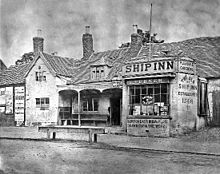Camp Hill, Birmingham
Camp Hill | |
|---|---|
 Church of the Holy Trinity | |
| Coordinates: 52°28′05″N 1°52′44″W / 52.468°N 1.879°WCoordinates: 52°28′05″N 1°52′44″W / 52.468°N 1.879°W | |
| Country | England |
| County | West Midlands |
| City | Birmingham |
Camp Hill is an area of Birmingham, West Midlands, England.[1]
The area's name was first recorded as Kempe Hill, derived from a family name, in 1511,[1] but it became known as Camp Hill after Prince Rupert set camp there in 1643, prior to the Battle of Camp Hill, during the English Civil War,[1] reputedly using the Ship Inn as his headquarters.[2]
The area is dominated by a former Commissioners' Church, the Church of the Holy Trinity, designed by Francis Goodwin in decorated perpendicular gothic style and built from Bath stone in 1820–1822.

Another notable local building is timber-framed Stratford House, built in 1601 and now a scheduled Ancient Monument and Grade II* Listed.[1]
The former King Edward VI Camp Hill School for Boys building is now a community centre; the school relocated to Kings Heath in 1956.
The area was formerly served by Camp Hill railway station, which closed in 1941. The Warwick and Birmingham Canal, part of the Grand Union Canal, passes through the area, with a set of six locks, known as Camp Hill Locks.
Transport[]
The A34 Stratford Road meets Birmingham's Middleway at Camp Hill Circus.
In 1931 an Act of Parliament was passed authorising modernisation a key part of the Grand Union Canal. The Braunston-Birmingham section had been built narrow and the locks could accommodate only a single narrowboat. The section between Napton and Camp Hill Top Lock was rebuilt to take widebeam boats or barges up to 12 feet 6 inches (3.81 m) in beam, or two narrowboats. The canal was dredged and bank improvements carried out: the depth was increased to 5 feet 6 inches (1.68 m) to allow heavier cargoes, and the minimum width increased to 26 feet (7.9 m) to enable two boats of 12 feet 6 inches to pass. Lock works were completed in 1934 when the Duke of Kent opened the new broad locks at Hatton, and other improvements finished by 1937.
However, these improvements to depth and width were never carried out between Braunston and London. Camp Hill Locks in Birmingham were not widened, as it would have been very expensive and of little point, since they lead only to further flights of locks not in the ownership of the Grand Union. A new canal basin and warehouse were constructed at Tyseley, above Camp Hill, to deal with this. Although the Grand Union company had a number of broad boats built to take advantage of the improvements, they never really caught on and the canal continued to be operated largely by pairs of narrow boats, whose journeys were facilitated by the newly widened locks in which they could breast up.
References[]
- ^ a b c d "Camp Hill". History of Birmingham Places & Placenames. Retrieved 10 May 2012.
- ^ "The Old Ship Inn, Camp Hill". Birmingham City Council. Retrieved 10 May 2012.
- Areas of Birmingham, West Midlands
- West Midlands (county) geography stubs

